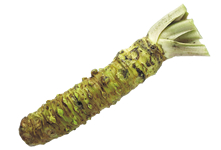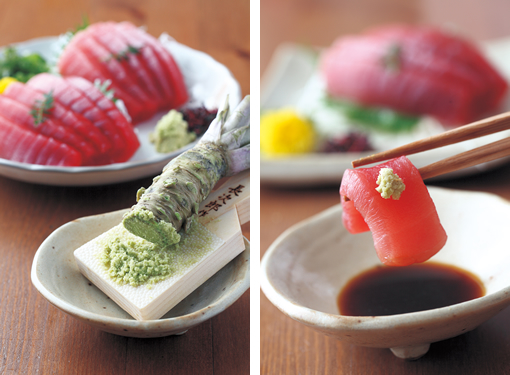niponica is a web magazine that introduces modern Japan to people all over the world.
2014 No.13

To read the e-book you need to have JavaScript enabled in your browser and a free Flash Player plug-in from Adobe Systems Inc. installed.
 Tasty Japan: Time to Eat!
Tasty Japan: Time to Eat!

Wasabi
Playing a small yet famously spicy role in Japanese cuisine
Photos by Natori Kazuhisa Collaboration: Tamaruya Honten

The most commonly eaten part of the wasabi plant is the stem. The leaf stalks and leaves are generally pickled.
It would be hard to imagine sashimi or nigiri-zushi without wasabi. Wasabi dissolves in soy sauce to make a zesty dip for sashimi slices of raw fish, and gives a nice bite when spread thin between the sushi rice and the nigirizushi fish. Its sharp edge kindles up the nasal passages, takes away the fishy smell, and brings out the flavor.
Wasabi comes from a plant native to Japan. A perennial in the mustard family, in science it goes by the name Wasabia japonica. It is mentioned in Japanese literature as far back as the 10th century. The underground stem is finely grated to make a paste that has a distinctively zesty bite. One of the ingredients, allyl mustard oil, has antibacterial properties which keep food freshness. In addition to the stem, the leaf stalks and leaves can also be eaten, generally in pickled form.

Wasabi grown at the Tamaruya Wasabi Farm in Fujinomiya, Shizuoka Prefecture.
Bottom left: A river of pure, clear water flows nearby.
Whether growing in the wild beside mountain streams or cultivated in narrow valleys, the wasabi plant needs sparklingly pure, running water. Certain locations in Fuji’s foothills are known for growing it. The photos above were taken at a wasabi farm in Fujinomiya, Shizuoka Prefecture, where underground water wells up in numerous springs, creating a naturally hydroponic environment. The nearby Shiba River, fed by springs on Mount Fuji, is swollen and flows so fast that its spray fogs the air. The mountain itself has no rivers, ponds or lakes, but rainwater and melted snow get filtered for a long time underground, finally bubbling up at lower elevations. That water ends up in rivers and lakes.
Water from Mount Fuji is rich in minerals, “and that’s ideal for wasabi plants,” says Kinezuka Mami of the farm. Their plants are bedded in sandy soil with a mix of gravel from the mountain. The temperature of the water coming from underground remains constant, between 10 and 11°C throughout the year. The plants require around 18 to 24 months before their white flowers bloom, showing that the underground stems are big enough to harvest. This farm uses staggered planting so the stems can be harvested year-round.
The important thing is to keep the water at a constant temperature and at a steady flow. Anything that impedes the flow, like litter or waterweeds, has to be removed without fail. The rivers become muddy after a heavy rain and this could cause discoloration, so the workers have to manage the situation and of course limit inflow.
“Our water and gravel—they both come from Mount Fuji,” says Kinezuka. “Thanks to Fuji, we produce really tasty wasabi.”
Wasabi commands a high price, so substitutes based on horseradish are often used today. But they cannot achieve the refreshing bite that is special to wasabi. Taking advantage of Japan’s water-rich topography and climate, wasabi plays an impressive supporting role in Japanese cuisine.

Left: The piquant bite of the wasabi plant is obtained by grating the stem.
Right: Wasabi takes away the fishy smell and brings out the flavor.


